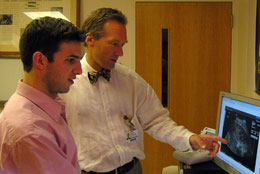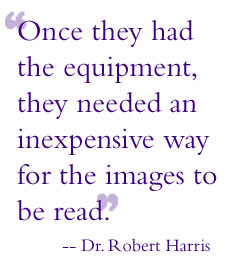|
|
For Release: May 17, 2005
Contact: DMS Communications (603) 650-1492
Ultrasound Images Transmitted Over the Phone Allow Radiologists to Diagnose Patients in Poorer Countries in Real Time
HANOVER, NH - Over-the-phone transmission of diagnostic-quality ultrasound images is possible, potentially paving the way for ultrasound examinations to be performed in poorer areas of the world, inexpensively transmitted via the Internet, and read by experienced radiologists elsewhere, a new Dartmouth Medical School study shows.

Veljko Popov (left) and Dr. Robert Harris discuss a patient's ultrasound image.
The study was prompted in part by Veljko Popov, an MD/PhD student at Dartmouth Medical School (DMS) who wanted to help the people in his homeland of Yugoslavia. Using a grant from the Dartmouth International Health Group, Popov and Robert Harris, MD, associate professor of radiology at DMS, visited patients at a remote hospital in Yugoslavia. They used a portable, compact ultrasound unit, donated by Dartmouth-Hitchcock Medical Center, to examine several hundred patients but the hospital had no resources to read the ultrasound scans. "Once they had the equipment, they needed an inexpensive way for the images to be read," said Harris.
"We conducted a pilot study in which 50 thyroid, abdominal, pelvic and transvaginal images were transmitted from Yugoslavia to the U.S. to determine if real-time, low-cost tele-ultrasound was feasible," said Popov. Real-time images were compressed to help speed the file transfer and these images were then compared to the original non-compressed images.

Two attending radiologists, one radiology resident and a medical student reviewed both sets of images, and in 64% of the cases, they could not tell the difference between the compressed and non-compressed images, said Harris. "In 67% of the cases, they ranked the compressed images as adequate for diagnostic purposes or better than adequate," he added. "The portable ultrasound machine we used to create the images in Yugoslavia is a relatively simple machine and, in some of the cases, the resolution problems could have been more of a problem with the original images than the compressed images."
"Our objective is to use these technological advances in places in the world, such as in Yugoslavia, where they are not readily available," said Popov. This pilot study was a first step to achieving that goal, he said.
"This pilot study shows that it is possible to inexpensively send adequate images across telephone lines," said Harris, who directs the ultrasound program at Dartmouth-Hitchcock Medical Center. "Our next step," said Popov, is to utilize satellite capability in an effort to expand bandwidth and speed file transfer, and connect remote areas of the world that do not have any internet access at all."
Popov and Harris will present the study at the American Roentgen Ray Society Annual Meeting in New Orleans, May 17.
Click here to download a video clip about this project.
-DMS-